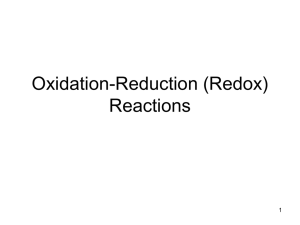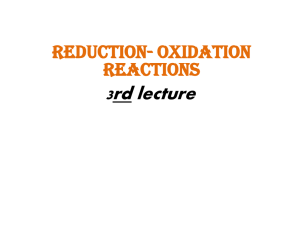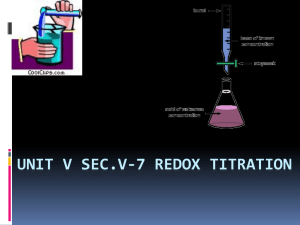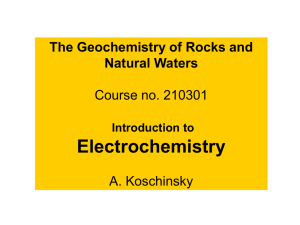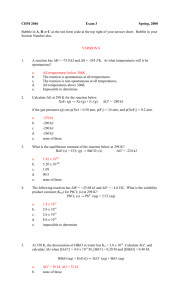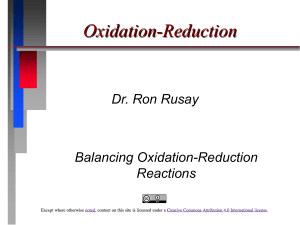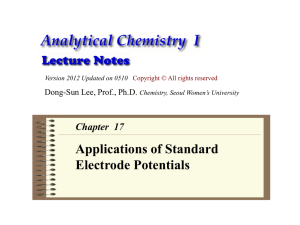Lecture 3-15-11
advertisement
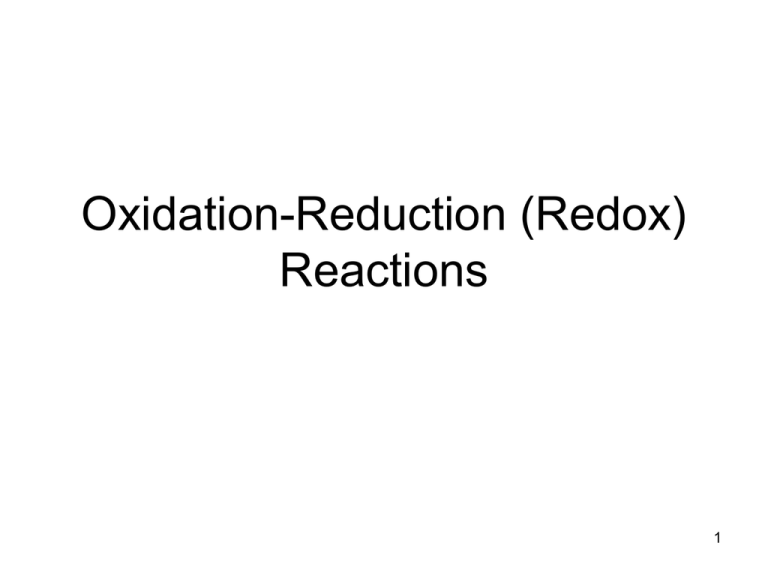
Oxidation-Reduction (Redox) Reactions 1 Measuring voltage • Standard potentials (E°) have been determined for how much voltage (potential) a reaction is capable of producing or consuming at standard conditions • Nernst Equation 2 Standard Potentials Written as reductions Strong Reducing Agents Half-Reaction Li+(aq) + e- → Li(s) K+(aq) + e- → K(s) Ba2+(aq) + 2 e- → Ba(s) Sr2+(aq) + 2 e- → Sr(s) Ca2+(aq) + 2 e- → Ca(s) Na+(aq) + e- → Na(s) Mg2+(aq) + 2 e- → Mg(s) Be2+(aq) + 2 e- → Be(s) Al3+(aq) + 3 e- → Al(s) Mn2+(aq) + 2 e- → Mn(s) 2 H2O + 2 e- → H2(g) + 2 OH-(aq) Zn2+(aq) + 2 e- → Zn(s) Cr3+(aq) + 3 e- → Cr(s) Fe2+(aq) + 2 e- → Fe(s) Cd2+(aq) + 2 e- → Cd(s) PbSO4(s) + 2 e- → Pb(s) + SO42-(aq) Co2+(aq) + 2 e- → Co(s) Ni2+(aq) + 2 e- → Ni(s) Sn2+(aq) + 2 e- → Sn(s) Pb2+(aq) + 2 e- → Pb(s) 2 H+(aq) + 2 e- → H2(g) E0 (V) -3.05 -2.93 -2.90 -2.89 -2.87 -2.71 -2.37 -1.85 -1.66 -1.18 -0.83 -0.76 -0.74 -0.44 -0.40 -0.31 -0.28 -0.25 -0.14 -0.13 0 The greater the E°, the more easily the substance reduced Half-Reaction E0 (V) 2 H+(aq) + 2 e- → H2(g) 0 4+ 2+ Sn (aq) + 2 e → Sn (aq) 0.13 2+ + Cu (aq) + e → Cu (aq) 0.13 2+ SO4 (aq) + 4 H (aq) + 2 e → SO2(g) + 2 H2O 0.20 AgCl(s) + e → Ag(s) + Cl (aq) 0.22 Cu2+(aq) + 2 e- → Cu(s) 0.34 O2(g) + 2 H2 + 4 e → 4 OH (aq) 0.40 I2(s) + 2 e → 2 I (aq) 0.53 MnO4 (aq) + 2 H2O + 3 e → MnO2(s) + 4 OH (aq) 0.59 + O2(g) + 2 H (aq) + 2 e → H2O2(aq) 0.68 Fe3+(aq) + e- → Fe2+(aq) 0.77 + Ag (aq) + e → Ag(s) 0.80 2+ Hg2 (aq) + 2 e → 2 Hg(l) 0.85 2+ 2+ 2 Hg (aq) + 2 e → Hg2 (aq) 0.92 + NO3 (aq) + 4 H (aq) + 3 e → NO(g) + 2 H2O 0.96 Br2(l) + 2 e- → 2 Br-(aq) 1.07 + O2(g) + 4 H (aq) + 4 e → 2 H2O 1.23 + 2+ MnO2(s) + 4 H (aq) + 2 e → Mn (aq) + 2 H2O 1.23 2+ 3+ Cr2O7 (aq) + 14 H (aq) + 6 e → 2 Cr (aq) + 7 H2O 1.33 Cl2(g) + 2 e → 2 Cl (aq) 1.36 Au3+(aq) + 3 e- → Au(s) 1.50 + 2+ MnO4 (aq) + 8 H (aq) + 5 e → Mn (aq) + 4 H2O 1.51 4+ 3+ Ce (aq) + e → Ce (aq) 1.61 + 2PbO2(s) + 4H (aq) + SO4 (aq) + 2e → PbSO4(s) + 2H2O 1.70 + H2O2(aq) + 2 H (aq) + 2 e → 2 H2O 1.77 Co3+(aq) + e- → Co2+(aq) 1.82 + O3(g) + 2 H (aq) + 2 e → O2(g) + H2O 2.07 F2(g) + 2 e -----> F (aq) 2.87 Strong Oxidizing Agents Redox Cell Pt wire electrode Salt bridge H2 gas (1 atm) Fe2+ and Fe3+ Fe3+ + e- ↔ Fe2+ ←: Pt wire removes electrons from half cell A →: Pt wire provides electrons to the solution [H+] = 1 H+ + e- ↔ ½ H2(g) 4 Redox Cell using Platinum • Voltage meter registers difference in potential (E) between the 2 electrodes – Potential of SHE = 0, so E = potential of electrode in half-cell A – Defined as Eh; measured in volts – Eh is positive when [e-] in solution A less than [e-] in SHE – Eh is negative when [e-] in solution A greater than [e-] in SHE 5 Eh as Master Variable • From electrochemistry: GR = -nF Eh – n = number of electrons – F = Faraday constant = 9.642 x 104 J / V∙mole – By convention, sign of Eh set for half-reaction written with e- on left side of equation – Can calculate E° = -GR° / nF (from Gf° values) • Determine GR° from the way the reaction is written (products – reactants) 6 Eh as Master Variable • From electrochemistry: GR = -nF Eh • Re-write Nernst Equation: – At 25°C – Oxidized species on side where e- are 7 Calculating Eh: Example • SO42- + Fe2+ + 8H+ + 8e- FeS + 4H2O 8 Eh and redox pairs • Redox pair = 2 species of an element with different valences – e.g., SO42- - H2S; Fe3+ - Fe2+ • For every redox pair in a solution, an Eh can be defined • What if a solution has more than one redox pair? – – – – An Eh can be calculated for each pair All Eh’s will be equal if system at chemical equilibrium But not so in nature, so different Eh values Therefore, there is no unique Eh of a solution 9 Measuring Eh • Eh is typically measured using a platinum (Pt) electrode + reference electrode – The reference electrode is a standard by which the Pt electrode measurement is made against • Ag:AgCl commonly used – Only responds to certain redox pairs – Doesn’t respond to solids – Best response to dissolved metals (e.g. Fe) – Better in reducing waters 10 Computed vs. Measured Field Eh - Internal equilibrium not achieved - Computed Eh values do not agree with measured - Note vertical bands - Horizontal positions of the vertical bands chiefly reflect the standard E° 11 Measured vs. Computed Eh - Samples with >1 redox pair - Points connected by vertical line derived from single sample - No internal redox equilibrium Lindberg, R.D. and D.D. Runnells (1984). Ground water redox reactions: an analysis of equilibrium state applied to Eh measurements and geochemical modeling. Science 225(4665):925-927. 12 Measuring Eh • The Eh value is usually not very accurate in natural waters because of a lack of redox equilibrium – One half of redox pair often below detection • It does usually give a good general idea of how oxidizing or reducing an environment is • Best to use Eh as a semi-quantitative measurement, giving you a relative idea of the redox potential of the water 13 Eh – pH Diagrams • A different type of stability diagrams, but using Eh as variable instead of activity – Lines indicate equilibrium – Domains define areas of stability for minerals and aqueous species 14 Water Stability Limits (H and O) in terms of pH and Eh • H2O(l) 2H+ + ½O2 + 2e• From thermodynamic data, get: – – – – – ΔGR° = 2Gf°(H+) + ½Gf°(O2) + 2Gf°(e-) - Gf°(H2O) ΔGR° = - Gf°(H2O) = 237.13 kJ/mole ΔGR° = -nF E° E° = ΔGR° / nF = 237.13 / [(2)(96.5)] = 1.23 V 15 Water Stability Limits (H and O) • • • Eh = 1.23 + 0.0148 log[O2] – 0.059 pH • Establishes relationship among Eh, pH, and fO2 – f = fugacity; basically activity of a gas 16 Water Stability Limits (H and O) • What are the stability limits of liquid water on Earth? – 2H2O(l) 2H2(g) + O2(g) – ΔGR° = 2 x 237.13 kJ/mole; K = 10-83.1 – At equilibrium, [O2][H2]2 = 10-83.1 • Total pressure of all gases occurring naturally at Earth’s surface must be ≤ 1 atm – If > 1, bubbles form in water exposed to the atmosphere and gases escape – So, fO2 and fH2 must each be ≤ 1 atm for liquid H2O to be stable – So if fH2 is at its maximum (1 atm), [O2] = 10-83.1 17 Water Stability Limits (H and O) • So, fO2 can vary between 1 – 10-83.1 in equilibrium with H2O(l) at Earth’s surface • Eh = 1.23 + 0.0148 log[O2] – 0.059 pH – For O2 = 1 atm, Eh = 1.23 – 0.059 pH – For O2 = 10-83.1, Eh = 1.23 + 0.0148(-83.1) – 0.059 pH • Eh = 1.23 -1.23 - 0.059 pH • Eh = -0.059 pH 18 Eh-pH Diagrams • Eh = 1.23 – 0.059 pH (fO2 = 1 atm) • Eh = -0.059 pH (fO2 = 10-83.1 atm) – (y = mx + b) • These 2 equations plot as parallel straight lines on an Eh vs. pH plot (same slope) – And for any value of fO2, we would get additional parallel straight lines – Eh = 1.23 + 0.0148 log[O2] – 0.059 pH 19 O2 and H2 are present in entire H2O stability range Oxidizing and reducing with respect to SHE Oxidizing environments may contain only small amounts of O2 20 Oxygen • Most common and strongest oxidizing agent at the Earth’s surface is dissolved O2 • Consider pH = 7, Eh = +0.6 V – In groundwater environments, this is very oxidizing – Eh = 1.23 + 0.0148 log[O2] – 0.059 pH – [O2] = 10-14.6 atm 21 Oxidizing environment, but death to fish 22 Eh-pH Diagrams • Positive Eh = oxidizing environments; tend to function as electron acceptors • Negative Eh = reducing environments; tend to function as electron donors 23 24 Stability of Iron Compounds as a function of Eh and pH • Iron (Fe) is a common element on Earth, and is found in many forms and several valence states – Two main valence states are +2 (ferrous) and +3 (ferric); also 0 for native Fe – Solid phases: oxides, oxyhydroxides, sulfides, carbonates, silicates, native – Dissolved: usually Fe2+, Fe3+ in acidic, oxidizing waters – Common nuisance contaminant in groundwater – Important in biochemical processes; essential nutrient 25 Plotting Fe reactions on Eh-pH Diagram • • • • Select compounds and reactions of interest Consider solubilities of iron oxide Hematite (Fe2O3) 2Fe2+ + 3H2O Fe2O3 + 6H+ + 2e– – – – – (note: by convention, e- always on right side of reactions) GR = +126.99 kJ/mole E = +0.66 V Eh = 0.66 – 0.178 pH – 0.0592 log [Fe2+] This produces a family of parallel lines (when [Fe2+] is defined expressing solubility of hematite in Eh-pH plane 26 0 [Fe2+] = 10-4 –.5 0 2 4 –6 [Fe2+] = 10-8 .5 Fe ++ Hematite [Fe2+] = 10-6 25°C 6 8 pH 10 12 Walt Mon Feb 06 2006 ++++ Fe 2(OH) 2 , 3 4 2 Fe (OH) (5 ), Magnetite, Fe(OH) (ppd) + Diagram Fe , T = 25 °C , P = 1.013 bars, a [main] = 10 , a [H2 O] = 1; Suppressed: FeO(c), Goethite, Fe(OH)3 (ppd), Fe(OH)3 , Fe+++, Fe(OH)- , Fe(OH)+, FeOH++, 4 2 ++ Eh (volts) 1 Solubility increases with decreasing pH and Eh; i.e., hematite dissolved under these conditions 14 27 Plotting Fe reactions on an Eh-pH Diagram • Next, magnetite (Fe3O4) and Fe2+ • 3Fe2+ + 4H2O Fe3O4 + 8H+ + 2e- – GR = +169.82 kJ/mole – E = +0.88 V – Eh = 0.88 – 0.237 pH – 0.089 log [Fe2+] 28 –6 10-4 0 [Fe2+] = 10-6 10-8 .5 Fe ++ Magnetite 0 –.5 25°C 2 4 6 8 pH 10 12 Walt Mon Feb 06 2006 FeOH , ++ ++++ , Fe (OH) 2 2 3 4 Fe (OH) (5 ) + Diagram Fe , T = 25 °C , P = 1.013 bars, a [main] = 10 , a [H2 O] = 1; Suppressed: FeO(c), Hematite, Goethite, Fe(OH)3 (ppd), Fe(OH)3 , Fe+++, Fe(OH)- , Fe(OH)+, 4 2 ++ Eh (volts) 1 14 29 Equilibria between Fe2+ and 2 minerals How do we determine where each mineral dominates? 30 Plotting Fe reactions on Eh-pH Diagram • Need to consider equilibrium between magnetite and hematite • 2 Fe3O4 + H2O 3Fe2O3 + 2H+ + 2e– GR = +41.33 kJ/mole – E = +0.21 V – Eh = 0.21 – 0.0592 pH – [Fe2+] not a variable, don’t have to define its activity 31 Equilibria between Fe2+ and 2 minerals 32 Equilibria between Fe2+ and 2 minerals 33 Plotting Fe reactions on Eh-pH Diagram • Iron can also be Fe3+ in solution • Consider relationship between Fe2+ and Fe3+ • Fe2+ Fe3+ + e– Eh = 0.77 V; independent of pH • Constant Eh, horizontal line 34 25°C 0 –6 0 2 .5 Fe ++ –.5 2 4 6 8 pH 10 12 Walt Mon Feb 06 2006 Fe 3(OH) 4(5 ), Magnetite, Fe(OH)2 (ppd), FeOH , Fe(OH)2 , Fe(OH)3 3 3, - + ++ ++++ Fe(OH)4, Fe(OH)2 , FeOH , Fe2 (OH)2 +++ + , T = 25 °C , P = 1.013 bars, a [main] = 10 , a [H O] = 1; Suppressed: FeO(c), Goethite, Fe(OH) (ppd), Fe(OH) Fe + +++ Diagram Fe Eh (volts) 1 14 35 , Plotting Fe reactions on Eh-pH Diagram • Iron can also be Fe3+ in solution • Fe2O3 + 6H+ 2Fe3+ + 3H2O – log [Fe3+] + 3 pH = -1.88 – Independent of Eh because no change in valence state (Fe in hematite is Fe3+ as well) • Constant pH, vertical line • Fe3O4 + 8H+ 3Fe3+ + 4H2O + e– Eh = -0.55 + 0.473 pH 36 0 2 Hematite Fe 0 –.5 Magnetite 25°C 4 6 8 pH 10 12 Diagram Fe , T = 25 °C , P = 1.013 bars, a [main] = 10 , a [H2 O] = 1; Suppressed: FeO(c) –6 ++ ++ Eh (volts) 1 Fe +++ .5 14 Walt Mon Feb 06 2006 37 Plotting Fe reactions on Eh-pH Diagram • Now let’s consider an iron carbonate mineral, siderite (FeCO3) • Fe is in the Fe2+ state (reduced); more common in subsurface • 3FeCO3 + H2O Fe3O4 + 3CO2 + 2H+ + 2e– Eh = 0.265 – 0.0592 pH + 0.0887 log [CO2] – At atmospheric PCO2 (3 x 10-4): • Eh = -0.048 – 0.0592 pH • Siderite-magnetite line plots below H2O stability limit • Thus siderite can’t precipitate unless PCO2 > atmospheric 38 Plotting Fe reactions on Eh-pH Diagram • FeCO3 + 2H+ Fe2+ + CO2 + H2O – K = ([CO2] [Fe2+]) / [H+]2 – 2pH = 6.958 – log [CO2] - log[Fe2+] • Note: it is independent of Eh (no e- transfer), so if we set [CO2] and [Fe2+], it’s a vertical line – For [CO2] = 10-2 and [Fe2+] = 10-6 mol/L, pH = 7.48 39 0 2 Hematite –.5 25°C 4 6 8 pH 10 - –2 + Fe +++ .5 Fe 0 Siderite Magnetite 12 Diagram Fe , T = 25 °C , P = 1.013 bars, a [main] = 10 , a [H2 O] = 1, a [HCO 3] = 10 ; Suppressed: FeO(c), FeCH3 COO , Fe(CH3 COO)3 , Fe(CH COO)+, FeCH COO++ 3 2 3 –6 ++ ++ Eh (volts) 1 14 Walt Mon Feb 06 2006 40 ++ 0 2 –.5 25°C 4 6 8 pH 10 -- Hematite 0 Pyrite Troilite Magnetite FeO(c) 12 –5 Diagram Fe , T = 25 °C , P = 1.013 bars, a [main] = 10 , a [H2 O] = 1, a [SO 4 ] = 10 –6 Fe ++ (speciates) Eh (volts) 1 Fe +++ .5 14 Walt Fri May 05 2006 41 Evolution of Water Chemistry 42 Source of dissolved species • Primarily from chemical weathering • Primary minerals + acid secondary minerals + dissolved ions – The essential ingredients needed to produce chemical weathering are water and acid – Water sources: start with precipitation 43 Chemical composition of precipitation (snow and rain) • Low TDS: ≤ 15 mg/L (water in contact with “rocks” for short period) • Acidic pH 5-6 naturally, in industrial area pH 3-4 (acid rain) • Dissolved ion composition variable, dependent on regional dust composition – e.g., in coastal areas Na+ and Cl- dominate (marine aerosols) – Regional limestones: Ca2+ and HCO3- dominate – Others: SO42- or NO3- can dominate • Also has dissolved gases: CO2 and O2 most important 44 Soils • In most areas, soils are the first geologic unit to come into contact with precipitation – Soils have the highest rate of chemical weathering – Soil CO2 increases due to decay of organic matter • When water reaches water table, TDS has usually increased by more than 10x • Complex interactions involving geologic materials (rocks or sediments), water, plants, animals, microorganisms, gases • Role of biology is key: produce acids (CO2 and organic), decay of organics, affect soil structure, bioturbation 45 Soil horizons O horizon: surface layer predominately organic matter A horizon: highly weathered, high organic matter, Fe/Al leached; high N B horizon: accumulated clay, Fe/Al hydroxides, humus (stable organic matter; gaseous diffusion and aqueous transport between B and C C horizon: altered parent material, solute and gases exchange with saturated zone; periodically saturated when water table high Saturated zone Zone of Leaching Zone of Accumulation Partly decomposed and unaltered bedrock 46 Soil reactions • Throughout soil column: – CO2 produced by decay of organics and plant respiration – O2 consumed by decay of organics and redox reactions (Fe and S minerals) – N cycling – Soils continually produce acid (carbonic and organic) 47 Soils and acidity • Soil CO2 is 10 – 100 X greater than in atmosphere, thus 10 – 100 X greater acidity – CO2 + H2O H2CO3 H+ + HCO3– Carbonic acid does most weathering • Organic acids: accounts for some weathering; also complexation with inorganic ions – Can affect solute transport mechanisms 48 Plants/Animals • Plants take up and release inorganic elements as nutrients – Seasonal affects • On a seasonal basis, element uptake does not equal its release • But on an annual basis, uptake approximately equals release • Over decadal-century time frame, uptake approximately equals release (steady state) • No steady state if crops are harvested; this is why fertilizers must be added 49 Generalized nutrient requirements of plants (molar) • • • • • • • • 800 CO2 6 NH4+ 4 Ca2+ 1 Mg2+ 2 K+ 1 Al(OH)2+ 1 Fe2+ 2 NO3- • • • • 1 H2PO41 SO42H2O Micronutrients: B, Cu, Mn, Mo, Zn, Cl• Na+ only major ion not involved in biological activity 50
